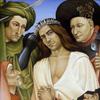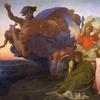A Pre-Raphaelite Discovery at The Maas Gallery
- LONDON, United Kingdom
- /
- September 07, 2015
After 160 years, this beautiful painting of the young Saint Elizabeth by Charles Collins, one of the most able of Pre-Raphaelite painters, has been recently rediscovered, and is now in the collection of a major American museum. At the time of the painting's exhibition in 1852 Collins was seen by the public as one of the three main artists of the Pre-Raphaelite Brotherhood, with Hunt and Millais. It disappeared two years later and it is extraordinary that such an important and truly Pre-Raphaelite painting from the period 1848-53 (after which time the Brotherhood had broken up) should resurface after being forgotten for so long.
Collins was proposed for membership of the Brotherhood in 1850 but in the absence of the required unanimity (Millais' brother William thought him too religious) he was not formally elected. His famous painting Convent Thoughts of the next year cast him as a central figure in the group, and caused him to be re-invited, but he demurred.
Collins had intended St Elizabeth to be ready for the Royal Academy in 1851, representing ‘Faith' as a companion picture to Millais' The Return of the Dove to the Ark, representing 'Hope', but Collins could not finish his picture in time and it was shown instead the following year.
Both it and the Millais, which are the same size and shape, are in identical frames designed by Millais, who, along with Hunt, was Collins' close friend. St Elizabeth is one of the first paintings to feature Elizabeth Siddal before she was claimed by Rossetti as his muse; it is also the first picture to feature the door used eventually by Holman Hunt in his famous The Light of the World.
The attention to detail and the brilliant colours of the ‘wet white ground' technique of early Pre-Raphaelite paintings mystified the public of the time, but most shocking of all was the religious subject matter, that was considered dangerously Catholic.
For more information about this story, here is a link to an article by Rupert Maas (Maas Gallery) about the artist and the picture that first appeared in The British Art Journal this summer, Volume XV, no. 3:










100x100_c.jpg)


![Offering a Truce [Bested], 1895, is estimated to sell for between $1,300,000 and $1,800,000 on March 22, 2014, for The Russell: An Exhibition and Sale to Benefit the C.M. Russell Museum. Offering a Truce [Bested], 1895, is estimated to sell for between $1,300,000 and $1,800,000 on March 22, 2014, for The Russell: An Exhibition and Sale to Benefit the C.M. Russell Museum.](/images/c/a8/20/Dec10_Offering_a_Truce__Bested_300dpi100x100_c.jpg)